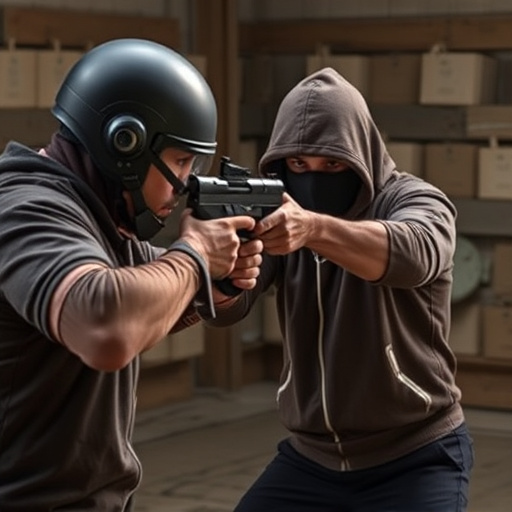Non-lethal pepper spray, composed primarily of capsaicin (oleoresin capsicum), temporarily incapacitates attackers by irritating eyes, noses, and respiratory systems. Balanced formulations make it safe yet potent for various assailants. Police use it as a last resort in crowd control and officer safety, while civilians can employ it for self-defense against imminent physical harm without causing permanent damage. As a crucial tool in non-lethal pepper spray defense, it deescalates violence effectively, making it a valuable addition to personal safety strategies.
“Uncovering the power of non-lethal pepper spray, this article delves into its complex composition and unparalleled effectiveness as a defensive tool. From law enforcement tactics to civilian protection, we explore how police grade pepper spray compounds play a pivotal role in modern security measures.
Learn about the strategic use of these agents, the rigorous training involved, and their ability to disrupt and disable without causing permanent harm. Discover why non-lethal pepper spray defense is an indispensable asset for both officers and those they protect.”
- Understanding Non-Lethal Pepper Spray: Its Composition and Effectiveness
- The Role of Police in Utilizing Pepper Spray: Strategies and Training
- Defensive Applications: How Non-Lethal Pepper Spray Protects Civilians and Law Enforcement Officers
Understanding Non-Lethal Pepper Spray: Its Composition and Effectiveness
Non-lethal pepper spray, also known as oleoresin capsicum (OC) spray, is a powerful defense mechanism designed to incapacitate an attacker temporarily without causing permanent harm. Its primary active ingredient is capsaicin, the compound that gives chili peppers their heat. When deployed, the spray irritates the eyes, nose, and respiratory system, leading to temporary blindness, congestion, and difficulty breathing. This disruption significantly reduces an individual’s ability to fight or flee, providing users with a crucial window of opportunity to escape or seek help.
The composition of non-lethal pepper spray includes not just capsaicin but also various other chemical agents and carriers that enhance its effectiveness and usage. These formulations are designed to balance potency with safety, ensuring the spray is effective against a wide range of assailants without causing severe health complications. With proper training, individuals can use this tool responsibly, making it a valuable addition to personal safety strategies, especially in self-defense scenarios where de-escalation is crucial while neutralizing an immediate threat.
The Role of Police in Utilizing Pepper Spray: Strategies and Training
Pepper spray, a non-lethal pepper spray defense tool, plays a significant role in modern policing strategies. It is designed to incapacitate individuals temporarily while ensuring officer safety and minimizing potential harm during law enforcement operations. Police are trained to use pepper spray as a last resort when other de-escalation techniques fail, providing them with a crucial option for crowd control and managing aggressive subjects.
The training involves learning various application techniques, understanding the different types of pepper spray compounds, and recognizing the legal boundaries surrounding its use. Officers must master the timing and force required to deploy the spray effectively while minimizing impact on bystanders. Regular practice sessions help them become proficient in this skill, ensuring they can make split-second decisions during high-pressure situations.
Defensive Applications: How Non-Lethal Pepper Spray Protects Civilians and Law Enforcement Officers
Non-lethal pepper spray, often referred to as defensive pepper spray, plays a pivotal role in safeguarding both civilians and law enforcement officers. Its primary function is to incapacitate an aggressor temporarily, providing the user with precious time to escape or summon help. This is particularly crucial in high-risk situations where the immediate deescalation of violence is paramount.
Unlike lethal force, which carries significant consequences and legal implications, non-lethal pepper spray offers a measured response. It disrupts an individual’s vision, breathing, and mobility, rendering them temporarily neutralized. This defensive application ensures that law enforcement can handle dangerous scenarios while minimizing the risk of fatal outcomes. For civilians, it serves as a powerful tool for self-defense in situations where physical harm may be imminent.
Non-lethal pepper spray, with its precise composition and strategic application, serves as a powerful tool for both civilian protection and law enforcement. By understanding its unique chemical makeup and effectiveness, we can appreciate how it acts as a vital defense mechanism in various scenarios. The police grade inflammatory compound plays a crucial role in de-escalating conflicts, providing officers with a safe and reliable means to maintain order while safeguarding the well-being of all involved. As we’ve explored, proper training and strategic deployment are essential to ensure its safety and efficacy, making non-lethal pepper spray a game-changer in modern law enforcement tactics.
